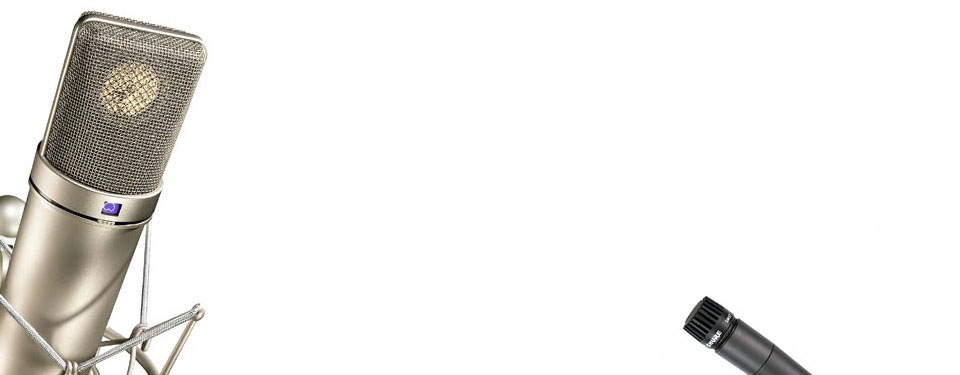You can read on below or click to watch our video playlist on microphones at our sister site ..
To begin, here are a few useful facts ...
- Condenser mics have a wide frequency response and are the preferred choice for recoding vocals and acoustic instruments.
- Condenser mics are not often used on stage. Because of their delicate sensitivity they are prone to feedback and handling noise.
- Dynamic mics are a good choice for live vocals, and recording drums and guitar amps in the studio.
- Recording studios need a wide range of mic models and types.
- If you can only afford one mic for recording it should be a condenser with switchable polar patterns, because these are the most versatile.
- Omni directional mics produce the most natural sound but because they pick up sound from all around they need to be used in acoustically controlled or treated spaces.
- If you are recording vocals you will almost always need a suspension mount, boom mic stand, a pop shield and a music stand.
- You should audition a mic before buying.
- The microphone pre-amplifier (mic pre-amp) is an important part of a mics sound. A given mic will not always sound the same between different mic pre-amps.
- Do not assume that large capsule condenser mics are more accurate than other designs, some are not. We like them because they flatter the sound.
- If a mic does not have a canon / XLR connector, it is almost certainly not a professional model and may suffer from a loss of treble and interference if the connecting cable is long.
Basic microphone design terminology diagram
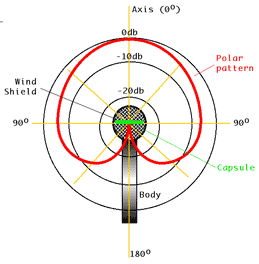
Basic design principals
A soundwave entering a mic causes a diaphragm to vibrate. Put simply, as the diaphragm moves backwards (when compression hits it) and forward (when rarefaction hits it) it causes a magnet to move inside a coil of wire. In accordance with Faraday's principles of electromagnetism, this induces (creates) an electrical signal in the coil which rises and falls in pressure (voltage) according to the movement of the magnet. Thus a pattern of changing electrical pressure is created which tracks exactly the pattern of changing air pressure energy entering the mic.
In order to capture the detail of the air pressure soundwave, the diaphragm moves microscopically. Thus the electrical pressure soundwave the microphone produces is very low in amplitude. This signal must be sent to a mic pre-amp (perhaps in a mixing desk), via a balanced lead (which protects it on its journey), where it will be boosted to so called "line level".
Transducers
A transducer is a device for converting one form of physical energy into electricity or vice versa. A microphone converts sound energy (vibrations in the air) into electrical energy. Although occurring together the transducing process in a mic combines two stages:
- 1st Stage: Sound waves create changes in air pressure which cause a lightweight diaphragm to vibrate.
- 2nd Stage: The mechanical motion of the diaphragm is used to generate an alternating voltage.
Capsule
In a microphone the transducer is built into a capsule incorporating a diaphragm which is protected from the user by a metal grille. The capsule is normally mounted onto the mic body which contains the necessary electronics, transformers and connectors.
Sold state and valve electronics
Before transistors, mics used valves as part of their electronics. Valve mics tend too have a narrower frequency range and are less transparent (their frequency curves are not flat) than modern solid state designs, but are favoured because of the character and warmth (pleasant harmonic distortion) they can add to a sound.
Axis
A line drawn through and at 90 degrees to the capsule is called the axis. The mic will be most sensitive to sound arriving along this line. Sound arriving from any other direction is said to be off-axis.
Proximity effect
This occurs with mics in which the capsule employs a pressure gradient design (cardioid and figure of eight). Essentially low frequencies are accentuated when the sound source is very close to the mic (most noticeable within just a few inches).
Handling noise
This is the mechanical transfer of vibration from the body to the capsule.
Popping noise
This is a low frequency boom caused by excessive air pressure (or wind) usually caused by a singer pronouncing Ps and Bs.
Directionality (polar pattern)
Different mics respond differently to sounds arriving from different directions. Some pick up sound equally well from all around. Some are designed to pick up sound approaching from one direction whilst others pick up sound from the front and rear but not the sides. Many modern studio mics combine both pressure-operated (PO) and pressure-gradient (PG) transducer design to produce varying patterns of directivity between omni-directional and figure of eight.
These five most common directional characteristics are known as:
- Omni-directional (all around)
- Figure of eight (bi-directional) front and rear
- Cardioid (unidirectional) heart shaped
- Super cardioid
- Hyper cardioid
A given mics pattern of directivity (called its polar pattern) is defined by the particular transducer design implemented in its capsule.
A polar diagram (or polar pattern) is a form of two-dimensional contour map showing the mics output (usually in dB) at different angles of incident of a sound wave. The greater the plot from the centre the greater the output of the mic at that angle.
It should be stated that diagrammatic representation of a given capsules polar pattern is intended to show its average response. Exact patterns will be frequency dependent. In general most off-axis attenuation occurs with higher frequencies where wavelength is shorter and the masking effect of the body is therefore greatest.
| Omni-directional | Figure of eight | Cardoid | Super cardoid | Hyper cardoid | |
|---|---|---|---|---|---|
| Polar pattern response |  |
 |
 |
 |
 |
| Angle at which output = 0 | -- | 90 & 270 degrees | 180 degrees | 126 & 234 degrees | 110 & 250 degrees |
| Distance factor | 1 | 1.7 | 1.7 | 1.9 | 2 |
Pressure operation capsule from an omni-directional microphone & Polar patterns at different frequencies.
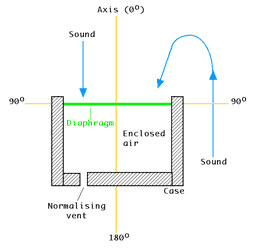
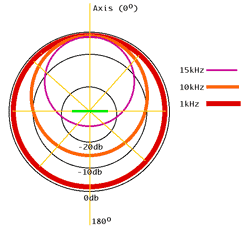
Omni directional
A mic capsule employing a pressure operation design leaves the diaphragm open to the air on one side and enclosed on the other. As the air pressure changes in response to sound waves the diaphragm moves inwards and outwards.
Because such a mic responds to changes in air pressure it should be equally sensitive to sounds coming from any direction. Its response characteristic (polar pattern) is circular and called omni-directional. In practice however, the physical body of the microphone itself produces a masking effect which tends to effect its sensitivity to off-axis high frequency sound.
Such a mic will pick up all ambient (direct plus reverberant) sound. They are arguably the most natural sounding because they reproduce off-axis sound faithfully. They do not suffer from the proximity effect in the way that cardioid and figure of eight designs do. They are most immune to handling and wind noise. Also they have a greater capacity for handling high SPL's (Sound Pressure Levels).
Pressure gradient capsule & Pressure gradient figure of 8 polar pattern
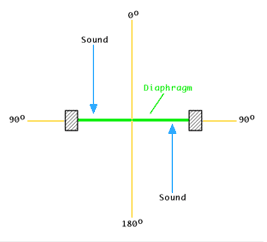
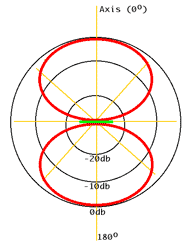
Figure of eight
A microphone capsule employing a pressure gradient design leaves the diaphragm open to the air on both sides. The force acting on it can be expressed in terms of the pressure difference or gradient at the two faces. Here the mic is most sensitive at two points along the axis, at 0 and 180 degrees and least sensitive at 90 degrees.
A mic employing this design will produce the characteristic figure of eight or bi-directional polar pattern. Rejection at 90 degrees means that a microphone employing this pattern may be set back from the source 1.9 times further than a omni-directional microphone for a given ratio of direct to reverberant sound.
Such a mic is generally used only for specialist stereo applications. They can be useful for recording two singers simultaneously, one at the back and one at the front.
Pressure gradient cardioid polar pattern
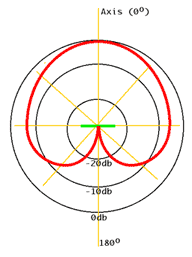
Cardioid
Another type of mic capsule employing a type of pressure gradient design produces a unidirectional or cardioid polar pattern. Like the figure of eight capsule the diaphragm is open to the air on both sides but here the air arriving from the rear is delayed by a complex sound path design. The result is a polar pattern in which the mic is most sensitive to on- axis sound arriving at the front.
This is the most directional pattern and the best choice when rejection of sounds from the back (180o) is required. Off axis rejection means that a microphone employing this pattern may be set back from the source 1.7 times further than a omni-directional mic for a given ratio of direct to reverberant sound.
Such mics are favoured when spill from nearby sound sources (other musicians perhaps) needs to be kept to a minimum in live or studio conditions. In common with figure of eight microphones they suffer from the proximity effect.
Super cardioid
This cardioid variation is strongly directional. Off axis rejection means that a mic employing this pattern may be set back from the source 1.9 times further than an omni-directional mic for a given ratio of direct to reverberant sound.
Hyper cardioid
This cardioid variation is also strongly directional. Altering the balance of PO and PG creates an asymmetrical figure-of-eight like pattern. Off axis rejection means that a mic employing this pattern may be set back 2.0 times further than an omni-directional mic for a given ratio of direct to reverberant sound.
Impedance & mic pre-amps
Mics produce very quiet electrical pressure soundwaves which must be amplified by a mic pre-amp to line level before they can be recorded and processed. The interaction between the mic pre-amp and mic can have a dramatic impact on the performance of the mic and the sound it produces. Changes in interaction occur because of differing impedances in the designs of pre-amps and mics.
This interaction is most clearly heard in changes of level and frequency response. Most dynamic and condenser mics have a low output impedance of around 150-300 ohms and this makes them suspect to the varying input impedances of pre-amps. Should the mic and pre-amp impedances match there will be a severe loss of level and so pre-amps are designed with an impedance typically 10 times greater (1000 to 2000 ohms) than that of mics.
Ribbon mics have a very low impedance and therefore the sound can be greatly effected by differing mic pre-amps.
Here are some basic guidelines.
| Mic type | Mic impedance | Pre-amp impedance | Audible effect |
|---|---|---|---|
| Dynamic, condenser | 150-300 ohms | 1600 ohms | Typical impedance ratio produces effective "transparent" amplification |
| Dynamic, condenser | 200 ohms | 200 ohms | Impedance match produces unwanted output and signal to noise reduction of 6dB |
| Dynamic, condenser | 150-300 ohms | 1000 ohms | Low pre-amp impedance causes presence peaks and "designed" frequency response variations (warmth?) in the lows and mids to be emphasised. |
| Dynamic, condenser | 150-300 ohms | 2000 ohms | High pre-amp impedance causes flatter frequency response in low and mid range, but emphasised high frequency response (better "air" or ambience). |
| Ribbon | 30-120 ohms | 600 ohms | Using an impedance ratio of 1:5 will ensure effective operation with minimal changes to the ribbons designed frequency response |
The Shure SM57 instrument mic and SM58 vocal mic


Microphone types
Most microphones employ one of three design types ...
- dynamic
- ribbon
- capacitor (or condenser)
Dynamic (or moving coil)
The robustness of the dynamic mic makes it ideal for sound reinforcement use. They are both strong and cheap to manufacture. They can tolerate very high SPL's. and require no power supply. They are ideal for recording drums and loud amplified instruments. Also because they tend to accentuated frequencies in the upper-mid or ‘presence’ frequency range they flatter singers.
However they have a limited frequency response often limited to 16kHz. Also their low output makes them insensitive for studio work where it can be difficult to place them close enough to (for example) an acoustic instrument to get a good enough signal.
These mics tend to offer fixed un-switchable polar patterns, usually omni-directional and cardioid.
SE Electronics RNR1 ribbon mic
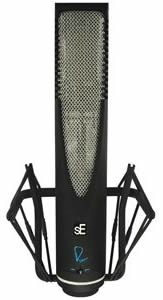
Ribbon
The ribbon mic works on electrical principle similar to the dynamic. They are more delicate but have a flat or smooth mid-range frequency response that rools off above 15kHz. Because of this they are favoured by classical and acoustic recordists for sources without hi-frequency such as electric guitar amps and brass instruments. They are also favoured as drum and orchestra overheads.
Early designs could not handle very loud sounds and were delicate. They are unsuitable for sound reinforcement use.
Recently there has been renewed interest in these designs and many new products have appeared.
Watch our comprehensive videos below ..
Ribbon microphones video
Connecting a ribbon microphone video
Capacitor / condenser
Because of the physical construction of the capsule, these mics are capable of reproducing a much wider range of frequencies than their dynamic counterparts, typically higher and lower than average human hearing. They are also very efficient giving them the best noise performance and highest sensitivity of all studio mics. Also these mics can be made with switchable polar patterns.
However, they are delicate and also require phantom powering, usually from a mixer, audio interface or mic pre-amp.
Back electret
A variation of the capacitor mic is the back electret which has its diaphragm polarised during manufacture. This simplifies the electronics and makes them cheaper to produce. Although these microphones are have been said to lose their charge and sensitivity over time, and produce an inferior sound to a true capacitor, this is no longer necessarily true with many excellent models (eg Audio Technica's 4030a) available.
Neumann U87 (left) - a studio standard condenser microphone, and the
sE Electronics 4400a - an excellent affordable Chinese made microphone
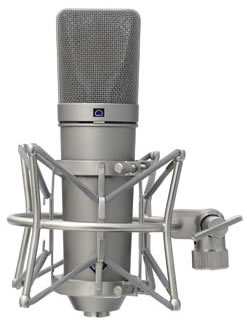
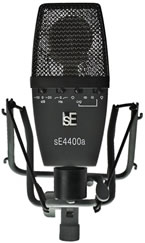
Controls
Mics, particularly capacitor types, may have on-board switches on their bodies, or on their separate power supplies, if they have one.
- Low Frequency Roll Off - This allows the user to cut low frequencies (typically at around 75 or 150Hz) by 10dB or so in situations where the proximity effect is a problem.
- Pad - This switch will cut the output of the microphone (typically by 10-20dB).
- Polar Pattern Select - A switch may allow omni-directional, figure of eight and cardioid polar patterns to be selected.
Mic techniques
This is a vast subject and one we hope to cover in the future.
Further reading
You may also wish to read ...
Glossary of microphone terminology
Ambient sound = Mix of direct and reverberant sound
Axis = A line drawn through and at 90 degrees to the capsule
Capsule = Point of sound incidence in a microphone
Bi-directional = Figure-of-eight polar pattern
Cardioid = Heart shaped polar pattern
Diaphragm = Sound sensitive point of incidence in capsule
Direct sound = That which arrives at the microphone directly from the source
Directivity = Pattern of sensitivity
Figure of eight = Bi-directional polar pattern
cardioid = Asymmetrical figure-of-eight polar pattern
Off axis sound = That which arrives at the diaphragm off axis
Omni-directional = Circular polar pattern
Polar Pattern = Diagram of a microphones output at different angles.
Pressure gradient (PG) = Diaphragm design open to air at back and front
Pressure operation (PO) = Diaphragm design open to the air on one side and enclosed on the other
Proximity effect = The tendency of cardioid and bi-directional microphones to boost low frequencies at close range, typically within a few inches of the capsule
Sensitivity = Electrical output for a given SPL
SPL = Sound pressure level
Super cardioid = Asymmetrical figure-of-eight polar pattern
Transducer = Device for converting one form of physical energy into electricity or vice versa

